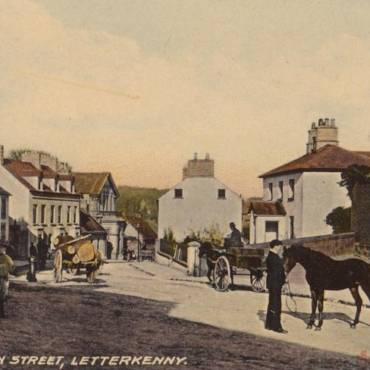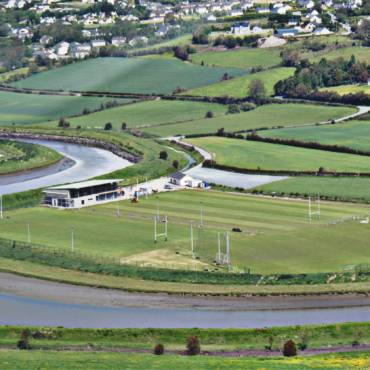ON THIS DAY: 21st June 1650: THE BATTLE OF SCARRIFHOLLIS
It was on this day 366 years ago that a decisive and bloody battle was fought at the ford of Scarrifhollis, just outside Letterkenny, between the forces of Bishop Heber McMahon’s Ulster Army and Sir Charles Coote’s Parliamentarians. But how and why did this battle come about?
In the thirty years that followed the Plantation of Ulster, religious tension had been growing steadily between the Irish Catholics and Protestant settlers, and by the early 1640s this tension erupted into outright rebellion. Following Sir Phelim O’Neill’s initial uprising, the long pent up resentment of the native Irish against the new planters exploded throughout the province. Filled with an insatiable lust for revenge and infused with a religious fervour, the natives plundered town after town throughout the province, in a period recorded as the 1641 Massacres (detailed transcripts of these events are available at 1641.tcd.ie).
Assistance to the planters arrived in the guise of Robert Munro, who landed at the Foyle in 1642, while in Donegal in the precinct of Portlough, the Laggan Army had been formed by Sir William Stewart. Eoghan Rua O’Neill, a nephew of Hugh, returned to Ireland in 1642, landing at Doe Castle to aid the Irish.
These events in Ulster coincided with the outbreak of the Civil War in England in 1642, and so, seeking to capitalise on the confusion overseas and to restore order on the island, leading members of the Catholic hierarchy met and formed the Confederation of Kilkenny. In January 1649, the Confederacy signed a treaty with the English Royalists but two weeks later, King Charles I was beheaded by the Parliamentarians and the victor in the Civil War, Oliver Cromwell, could now turn his attention towards Ireland. Still mindful of the exaggerated tales of the 1641 massacres against the settlers in Ulster, Cromwell made no secret of his primary motive of vengeance against the native Irish.
Eoghan Rua O’Neill died in November 1649, thus leaving the Ulster Army leaderless and despite his lack of military experience the young and dynamic clergyman Bishop Heber MacMahon was chosen as his successor. Following the capture of Charlemont, Dungiven and Ballycastle, MacMahon crossed the Foyle at Clonleigh and led the Ulster Army into the town of Letterkenny in June 1650. The settlers of the town at this time were too few to engage with this large army though and so withdrew to Inishowen for protection. Cromwell’s Parliamentarians, under the leadership of Sir Charles Coote crossed into Donegal at Lifford and followed them to Letterkenny.
Rather than engage with the Parliamentarians in the still relatively young market town, MacMahon chose the more defensive higher ground of nearby Dooen, near the crossing at Scariffhollis, to wait for their arrival. The terrain of this area suited this defensive stance, being rocky and inaccessible to horses. MacMahon, however, then made a fatal mistake while awaiting the arrival of Coote by allowing Col. McSwiney and 1,300 men to march on Doe Castle to secure the fort and return with provisions, depleting his numbers considerably as a result.
On the 20th of June, MacMahon could see Coote’s army on the opposite side of the river near Crieve/Rockhill. The Laggan Army had joined forces with the Parliamentarians and aided by reinforcements from Cols. Venables and Fenwick, Coote’s army now held approximately 3,000 men and 800 horses, outnumbering MacMahon’s 2,600 and 400. On the morning of the 21st June 1650, against the advice of his generals, MacMahon moved from his defensive position on the hill of Dooen and engaged Coote’s army on the flat lands around the river.
After about an hour of engagement, the Parliamentary forces utterly routed the Ulster Army. In the mayhem and panic that followed, many drowned in the river or were trapped in the silt of the tidal banks thus making them easy targets for ruthless execution. By sunset, the rout was complete.
For two days, Coote pursued the retreating Irish who had fled in all directions towards Glenfin, Fintown and Glenswilly and he showed no mercy in their capture, burning the small hamlet of nearby Conwal to the ground in the process. Bishop MacMahon escaped however and made his way to Enniskillen but was captured and beheaded six months later with his head being displayed on a pike at Derry’s gates. After this resounding defeat, the Ulster Army had been obliterated and the re-conquest of the northwest was complete.
Today in the town of Letterkenny, the estate of MacMahon Villas on the New Line Road is named after the defeated Bishop while at Scarrifhollis, a monument to the battle stands, erected in the year 2000 to mark the 350th anniversary.



